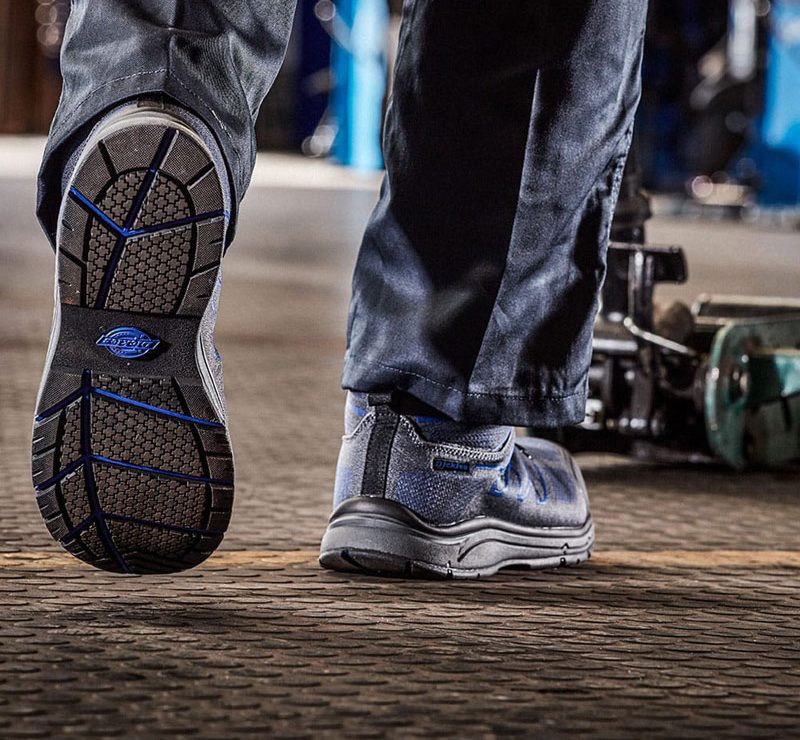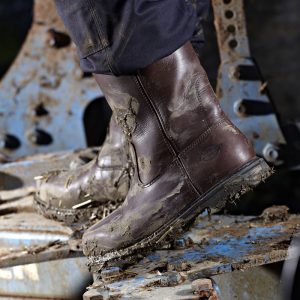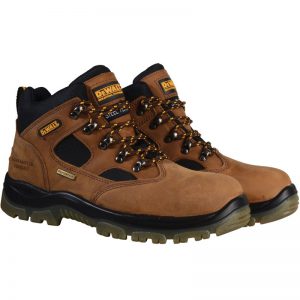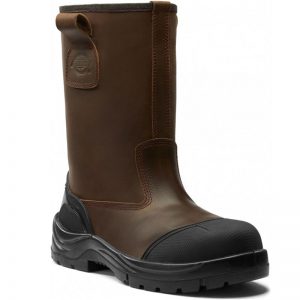Steel Toe Cap Vs Composite Toe Cap

Steel Toe Cap vs Composite Toe Cap Boots
If you’ve been shopping for a new pair of safety boots recently you may have wondered what the difference is between Steel toe cap vs composite toe cap safety boots (if any) as well as the protective midsoles that are often built in alongside them. Well if you’re still unsure, we’ve compiled this handy guide for you.
Safety Boot Basics
Safety boots are mandatory footwear on construction sites and in various industrial environments and other high risk workplaces – and with good reason too. Our toes are some of the most delicate parts of the body and they can be easily crushed and severely injured by any heavy objects that fall on them. The soles of our feet are likewise vulnerable to exposed nails and other sharp objects that are commonly encountered in construction environments. So even if safety boots aren’t enforced in your workplace, it makes sense to wear them if you think you’re at risk, especially since – as they are exempt from VAT –they are often surprisingly affordable.
Toe Caps and Soles

As identified above, the main injuries to the feet that are commonly encountered in hazardous workplaces occur from heavy objects crushing the toes and sharp objects penetrating through the sole of the foot. To safeguard against these hazards, safety boots usually employ a twofold protection barrier consisting of toe caps and anti-penetration midsoles, though it is also common to find work boots with toe caps only.
Steel or Composite?
Under European safety regulations, protective toe caps for work boots must be able to withstand 200 joules of impact energy. Thanks to its high strength and durability, steel has long been a material of choice for this application, and as a result everyone is familiar with the notion of steel toe cap boots; however, it is also possible to make modern composite materials that also match or exceed these requirements and anyone shopping for a new pair of safety boots is likely to come across models that advertise their use of composite materials as well as those that use steel, or in many cases, a combination of both (for example, steel toe caps with composite midsoles). So what are the advantages and disadvantages of each material?
Steel – Advantages

Steel provides excellent protection against both crushing damage and penetration from sharp objects. Although both steel and composite safety materials sold in the UK have to be manufactured within the specifications of European safety regulations, it is worth noting that steel can usually exceed this requirement by more than composite alternatives and therefore can be said to offer more protection to the wearer in extreme cases (though for general industrial use both should be fine). Steel is also cheaper to manufacture than the less common synthetic alternatives so it is usually a more affordable choice.
Steel – Disadvantages
However, steel is not without its drawbacks. Firstly, adding steel components to footwear quickly makes it heavier, and this extra weight can be fatiguing, especially if you have to move around a lot at work. Compounding this issue somewhat, metal toe caps also tend to trap heat and during the summer months steel toe capped safety boots can get uncomfortably hot. Conversely, metal can also become extremely cold when it is exposed to low temperatures, meaning that steel safety boots are often not choice footwear for working in cold storage facilities and similar environments. Additionally, if you work in a high security workplace like an airport or prison, you will most likely have to walk through a metal detector on a regular basis, and steel safety boots will trigger it every time.
Metal can also be hazardous in certain situations due to its high electrical conductivity and propensity to cause sparks if struck by another metal object, though as it is normally insulated by other materials inside the footwear this is not normally as much of a problem as might be assumed. Steel toe caps by themselves are not considered to pose any increased risk of electrocution as they are insulated by the rest of the shoe and do not typically come into contact with the ground. Metal midsoles are also typically insulated by other materials though they could potentially come into contact with the ground if the soles of the footwear are badly worn, and in this case they could pose an increased electrocution risk when working around live circuits. Likewise, if safety boots have been worn to the extent that metal components are exposed, there is a chance that they could cause sparks – making them hazardous for use in combustible environments. In any case, it is recommended that safety boots should be replaced as soon as possible in the event that the soles or toes become worn out.
Composite – Advantages

Designed to overcome some of the disadvantages of the traditional steel safety boot, composite materials (such as kevlar, carbon fibre, fibreglass and hard plastics) can firstly be more comfortable to wear: they are light – meaning they don’t drag your feet down like heavier boots can, and they don’t get excessively hot or cold. Non-metallic anti-penetration midsoles are also softer and more flexible than steel. This means that at the end of a hot summer’s day on site, composite work boots can definitely feel like an advantage. Secondly, as they are not metal based, they can be worn in high security workplaces without setting off metal detectors – though note it is still possible for composite safety boots to trigger metal detectors if they have other metal components (like eyelets). Some composite work boots are explicitly marketed as “metal free” to signify their compatibility with security systems.
Likewise, composite toe caps and midsoles pose no increased risk of electrical shock or of causing sparks, even if the boot becomes worn out or damaged. Composite midsoles can also be easily fitted along the whole length of the sole while with steel alternatives this is not always possible, due to the need for this part of the shoe to be flexible. This means they can offer more protection against nails, screws and other sharp objects.
Composite – Disadvantages
As stated before, although composite safety boots are manufactured within European guidelines for acceptable impact and penetration resistance, they can’t typically exceed this rating to the same extent that steel can (at least not with most of the current technology on the market). Therefore, if you work in extremely high risk environments, they may not offer quite as high a level of protection: if something really heavy is dropped on a composite toe cap it may crack or shatter. The other main disadvantage of composite materials is that they are more expensive to implement, and as such they are not usually as affordable as the traditional steel toe capped designs.
Conclusion
The choice of safety boot for your requirements is dependent on personal preference as well as environmental factors specific to your work environment. Bear in mind that toe caps and midsoles are not necessarily the only factors to bear in mind when choosing safety footwear, especially if you are working with electricity; for example, depending on the hazards of the environment you are working in, it may be necessary to wear either conductive, non-conductive or anti-static footwear to minimize any chance of electrical shock or explosion. However, hopefully this guide has proved useful for anyone who needs a pair of work boots for general protection, whether at work or for other activities like DIY. And if you’re in the market for some new safety footwear, why not check out our selection of work boots, work shoes and work trainers on the Tooled-Up website.

Hi there I’m looking for some information I work for building company and use steel lintels etc and wondering if steel toe cap boots are better on composite ones if i drop anything on my foot somethings can weigh up to over 200kg so I’m looking for the best to be safe thanks if you could reply that would be great.
Hi William – as it mentions in the post, composite toe caps have not historically been regarded as offering the same protection against especially heavy loads when compared with steel alternatives, as it is rare to find any composite material which can match the best steel toe caps for impact resistance. Depending on where you live in the world, you’ll probably find that both have to be made to an acceptable standard of crush/penetration resistance, but (generally speaking) steel has always been able to exceed this by a greater amount than composites. I’m sure it’s an area that manufacturers are still innovating in however, and it would be worth trying to find the specifications of any boots you’re interested in to get the best idea of which is going to offer you the most protection.